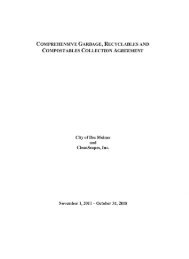CITY OF DES MOINES SHORELINE MASTER PROGRAM
CITY OF DES MOINES SHORELINE MASTER PROGRAM
CITY OF DES MOINES SHORELINE MASTER PROGRAM
Create successful ePaper yourself
Turn your PDF publications into a flip-book with our unique Google optimized e-Paper software.
Des Moines Shoreline Inventory and Characterization<br />
partially to completely eroded in places by subsequent glaciations or erosion during interglacial<br />
periods.<br />
The most recent incursion of glacial ice into the central portion of the Lowland is called the<br />
Vashon Stade of the Fraser glaciation, which receded from the area about 13,500 years ago.<br />
Since then, present-day geologic processes, such as erosion and deposition by streams and<br />
landsliding, have modified the ground surface and further complicated the geology. In addition,<br />
fill has been placed across much of the area for constructions of roads, businesses and Sea-Tac<br />
airport.<br />
Most soils exposed at the ground surface within the study area were deposited by the last glacial<br />
episode (Waldron, 1961 and 1962). Lodgment till mantles much of the upland area of Des<br />
Moines (Figure 4) but is generally absent along the steeper portions of the bluff at the edges of<br />
the upland. Lodgment till is an unsorted mixture of sand, gravel, silt, and clay deposited at the<br />
base of a glacier and has been compacted to a very dense state by the great weight of the<br />
overriding ice. Lodgment till has very low permeability and typically acts as an aquitard,<br />
restricting the downward flow of groundwater and reducing recharge of deeper aquifers.<br />
Recessional outwash and recessional lacustrine (lake) deposits of variable thickness commonly<br />
overlie the till. These sediments were deposited in topographic lows in the till surface where<br />
meltwater streams drained from the receding glacier, such as along the headwater areas of Des<br />
Moines and McSorely Creeks (Figure 4). Recent peat and muck deposits have accumulated on<br />
top of these poorly drained recessional lacustrine deposits or on top of recessional outwash<br />
deposits, where downward percolation of groundwater is impeded by the presence of till at<br />
shallow depths beneath the outwash. These areas of peat and muck deposits are also sites of the<br />
larger wetlands within the watershed (Figure 3).<br />
Underlying the till are thick deposits of sand and gravel separated by finer grained layers of clay<br />
and silt or tight, well-graded soils, such as till. These layers comprise several aquifers and<br />
aquitards within the subsurface and control subsurface water movement to the shoreline.<br />
Surface and Groundwater<br />
The Des Moines watershed lies within the South King County Groundwater Management Area<br />
(GWMA). Groundwater and hydrology of the watershed is well described in Luzier (1969) and<br />
Woodward et al. (1995). Additional analysis and groundwater protection planning are being<br />
conducted under King County’s Groundwater Management Program.<br />
The upland surface has several small lakes and numerous streams that flow short distances from<br />
the upland area to the shoreline (Figure 5). Precipitation falling within the watershed is<br />
conveyed directly to lakes and streams by surface runoff or travels in the subsurface as<br />
groundwater flow. Small amounts of rainfall soak into the ground, but during heavy rainfall, the<br />
ground quickly becomes saturated, inhibiting further infiltration. Water that is unable to<br />
infiltrate travels down slope across the ground surface as stormwater runoff. Surface runoff may<br />
erode soil, which is conveyed to streams and eventually to the shoreline of Puget Sound.<br />
Poorly drained areas of the upland plateau are the sites of former or existing wetlands. Wetlands<br />
regulate the flow of water within a watershed by storing water during precipitation events,<br />
slowing the conveyance of water from the upland to the shoreline, and increasing infiltration.<br />
Page 10 March 2005



